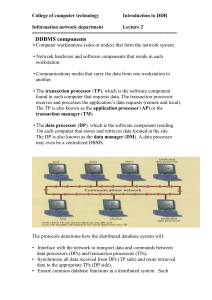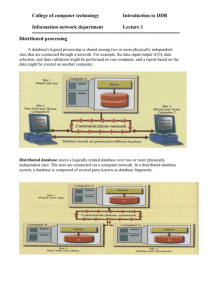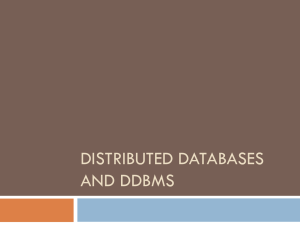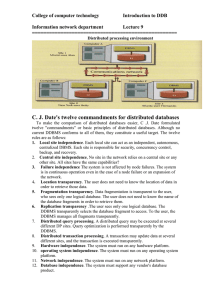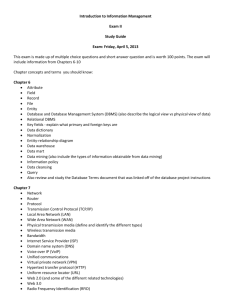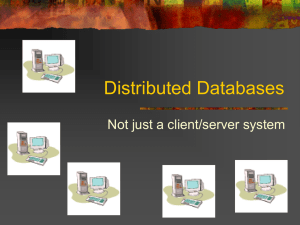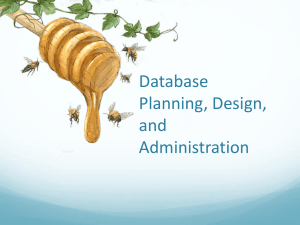College of computer technology ... Information network department Lecture 2
advertisement
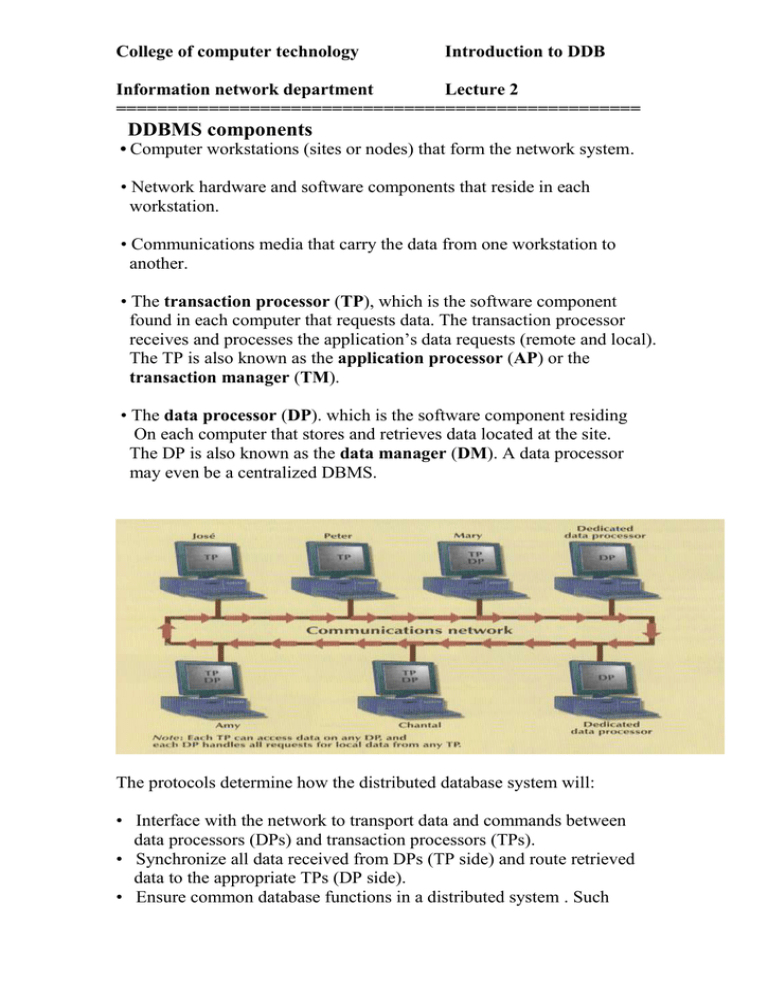
College of computer technology Introduction to DDB Information network department Lecture 2 =================================================== DDBMS components • Computer workstations (sites or nodes) that form the network system. • Network hardware and software components that reside in each workstation. • Communications media that carry the data from one workstation to another. • The transaction processor (TP), which is the software component found in each computer that requests data. The transaction processor receives and processes the application’s data requests (remote and local). The TP is also known as the application processor (AP) or the transaction manager (TM). • The data processor (DP). which is the software component residing On each computer that stores and retrieves data located at the site. The DP is also known as the data manager (DM). A data processor may even be a centralized DBMS. The protocols determine how the distributed database system will: • Interface with the network to transport data and commands between data processors (DPs) and transaction processors (TPs). • Synchronize all data received from DPs (TP side) and route retrieved data to the appropriate TPs (DP side). • Ensure common database functions in a distributed system . Such College of computer technology Introduction to DDB Information network department Lecture 2 =================================================== functions include security, concurrency control, backup, and recovery. LEVELS OF DATA AND PROCESS DISTRIBUTION Current database systems can be classified on the basis of how process distribution and data distribution are supported. SINGLE-SITE PROCESSING, SINGLE-SITE DATA (SPSD) In the (SPSD) scenario, all processing is done on a single host computer (single-processor server, multiprocessor server, mainframe system) and all data are stored on the host computer’s local disk system. The DBMS is located on the host computer, which is accessed by dumb terminals connected to it. This scenario is also typical of the first generation of singleuser microcomputer databases. From the figure above as an example, you can see that the functions of the TP and the DP are embedded within the DBMS located on a single computer. The DBMS usually runs under a time-sharing, multitasking operating system, which allows several processes to run concurrently on a host computer accessing a single DP. All data storage and data processing are handled by a single host computer. College of computer technology Introduction to DDB Information network department Lecture 2 =================================================== MULTIPLE-SITE PROCESSING, SINGLE-SITE DATA (MPSD) Under the (MPSD) scenario, multiple processes run on different computers sharing a single data repository. It is require a network file server running conventional applications that are accessed through a network. • The TP on each workstation acts only as a redirector to route all network data requests to the file server. • The end user sees the file server as just another hard disk. Because only the data storage input/output (I/O) is handled by the file server’s computer, the MPSD offers limited capabilities for distributed processing. • The end user must make a direct reference to the file server in order to access remote data. All record- and file-locking activities are done at the end-user location. • All data selection, search, and update functions take place at the workstation, thus requiring that entire files travel through the network for processing at the workstation. Such a requirement increases network traffic, slows response time, and increases communication costs. For example, suppose the file server computer stores a CUSTOMER table containing 10,000 data rows, 50 of which have balances greater than $1,000. SELECT * FROM CUSTOMER KHERE CUS_BALANCE> 1000; College of computer technology Introduction to DDB Information network department Lecture 2 =================================================== Client/server architecture is similar to that of the network file server except that all database processing is done at the perform multiple-site processing, the latter's processing is distributed. Note that a network file server approach requires the database to be located at a single site. In contrast, the client/server architecture is capable of supporting data at multiple sites . Multiple – site processing, multiple – site data (MPMD) The (MPMD)scenario describes a fully distributed DBMS with support for multiple data processors and transaction processors at multiple sites. depending on the level of support for various types of centralized. Homogeneous DDBMSs integrate only one type of centralized DBMS over a network .Thus, the same DBMS will be running on different server platforms. Heterogeneous DDBMSs integrate different types of centralized DBMSs over a network Fully heterogeneous DDBMSs will support different DBMSs that may even support different data models (relational, hierarchal, or network) running under different computer systems, such as mainframes and PCs . Some DDBMS implementations support several platforms, operating systems, and networks and allow remote data access to another DBMS. however, such DDBMSs still are subject to certain restriction . for example: Remote access is provided on a read –only basis and does not support write privilege. Restrictions are placed on the number of remote tables that may be accessed in a single transaction. Restrictions are placed on the number of distinct databases that may be accessed Restrictions are placed on the database model that may be accessed .Thus, access may be provided to relational databases but not to network or hierarchal databases. College of computer technology Introduction to DDB Information network department Lecture 2 =================================================== Distributed database transparency features DDBMS transparency features have the common property of allowing the end user to feel like the database's only user . In other words, the user believes that (s)he is working with centralized DBMS; all complexities of a distributed database are hidden ,or transparent to the user. The DDBMS transparency features are: • • • • Distribution transparency ,which allows a distributed database to be treated as a single logical database. If a DDBMS exhibits distribution transparency , the user does not need to know: - That the data are partitioned _ meaning the table's rows and columns are split vertically or horizontally and stored among multiple sites. - That the data can be replicated at several sites. - The data location. Transaction transparency, which allows a transaction to update data at more than one network site Transaction transparency ensures that the transaction will be either entirely completed or aborted. Thus, maintaining database integrity. Failure transparency. which ensures that the system will continue to operate in the event of a node failure. Functions that were lost because of the failure will be picked up by another network node. Performance transparency. which allows the system to perform as if it were a centralized DBMS. T system will not suffer any performance degradation due to its use on a network or due to the network-: platform differences. Performance transparency also ensures that the system will find the most cost-effective path to access remote data. Heterogeneity transparency. Which allows the integration of several different local DBMSs (relational. network, and hierarchical) under a common, or global, schema. The DDBMS is responsible for translating the data requests from the global schema to the local DBMS schema. College of computer technology Introduction to DDB Information network department Lecture 2 =================================================== Hetrogeneous distributed database scenario
